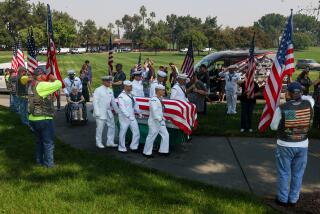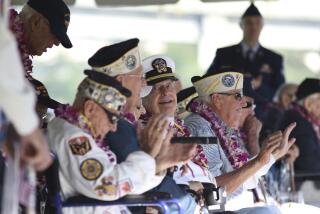Kermit A. Tyler dies at 96; officer didn’t act on radar warning about Pearl Harbor raid
- Share via
“Don’t worry about it.”
Those words, which he uttered on a peaceful Sunday morning in 1941 on the Hawaiian island of Oahu, would haunt Kermit A. Tyler for the rest of his life.
Tyler was the Army Air Forces’ first lieutenant on temporary duty at Ft. Shafter’s radar information center on the morning of Dec. 7, when a radar operator on the northern tip of the island reported that he and another private were seeing an unusually large “blip” on their radar screen, indicating a large number of aircraft about 132 miles away and fast approaching.
“Don’t worry about it,” Tyler told the radar operator, thinking it was a flight of U.S. B-17 bombers that was due in from the mainland.
Instead, the blip on the radar screen was the first wave of more than 180 Japanese fighters, torpedo bombers, dive bombers and horizontal bombers whose surprise attack on Pearl Harbor and the island’s main airfields shortly before 8 a.m. plunged the United States into World War II.
“I wake up at nights sometimes and think about it,” Tyler said in a 2007 interview with the Star-Ledger of Newark, N.J. “But I don’t feel guilty. I did all I could that morning.”
Tyler, who suffered two strokes within the last two years, died Jan. 23 at his home in San Diego at age 96, said his daughter Julie Jones.
After Pearl Harbor, Tyler flew combat missions in the Pacific. He retired from the Air Force as a lieutenant colonel in 1961 and earned a degree in business from what is now San Diego State.
He then launched a career in real estate and later became a landlord.
But there always was the memory of his role on Dec. 7, his infamous words immortalized in history books, articles, documentaries and a 1970 movie about the attack on Pearl Harbor, “Tora! Tora! Tora!”
Often ridiculed and second-guessed, Tyler occasionally received angry letters blasting him for not taking action that day.
And audiences watching the Pearl Harbor documentary at the Pearl Harbor Visitors Center theater still groan when they hear that Tyler’s response to the radar report was: “Don’t worry about it.”
“He’s certainly a footnote to the Pearl Harbor history and the most misunderstood actor in this drama,” said Daniel Martinez, chief historian for the National Park Service at World War II Valor in the Pacific National Monument in Pearl Harbor.
Tyler, a fighter pilot assigned to the 78th Pursuit Squadron at Wheeler Field, was working the 4 a.m.-to-8 a.m. shift as the officer on duty at the Ft. Shafter radar information center on Dec. 7.
“He was never trained for that job,” Martinez said. “He had a walk-through the previous Wednesday, but had never spent a full day there.
“The commanding general of Wheeler Field wanted young pilots to learn as much about the radar system as possible so they’d be more effective at intercepting enemy aircraft,” and Tyler was selected to be an observer-trainee in the radar information center.
Congressional committees and military inquiries that looked into what happened at Pearl Harbor did not find Tyler at fault, Martinez said.
Although the two radar operators thought the “blip” on their screen represented about 50 planes, Martinez said, they never volunteered that information to Tyler.
And, he said, there was indeed a flight of B-17s flying in from Hamilton Field north of San Francisco, and they were due to land at Hickam Field at 8 a.m.
“We look for simple answers and Kermit Tyler fit in as the fall guy for the attack -- that he was the one that didn’t act properly, that he made a misjudgment,” Martinez said. “What was lost is there’s a certain amount of culpability in the command of both the Army and the Navy.”
A wayside exhibit panel on the shoreline at Turtle Bay Resort on the North Shore of Oahu tells the story of the radar contact on Dec. 7. Included is a sidebar on Tyler’s role that ends with: “His assessment was based on deductive reasoning with limited information and two days’ experience. Would you have acted differently?”
Tyler was born April 21, 1913, in Oelwein, Iowa, and later moved with his family to Long Beach.
He attended junior college in Long Beach and spent two years in the Civilian Conservation Corps before being accepted into the Army for cadet flying training in 1936.
He was preceded in death by his wife, Marian, and a son, Michael.
In addition to his daughter Julie, he is survived by two other children, Carol Daniels and Terry Tyler; three grandchildren; and a great-granddaughter.
More to Read
Sign up for Essential California
The most important California stories and recommendations in your inbox every morning.
You may occasionally receive promotional content from the Los Angeles Times.













